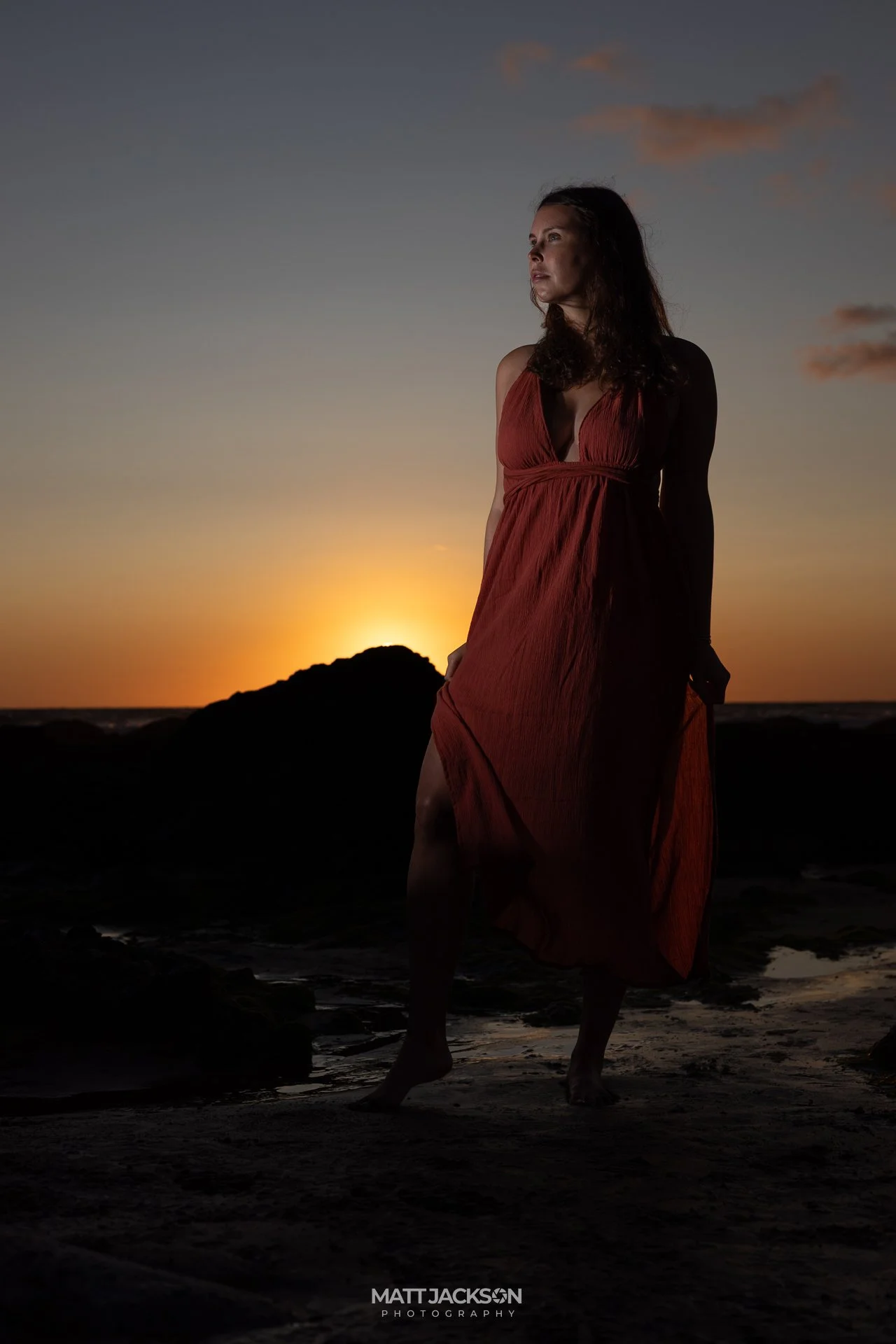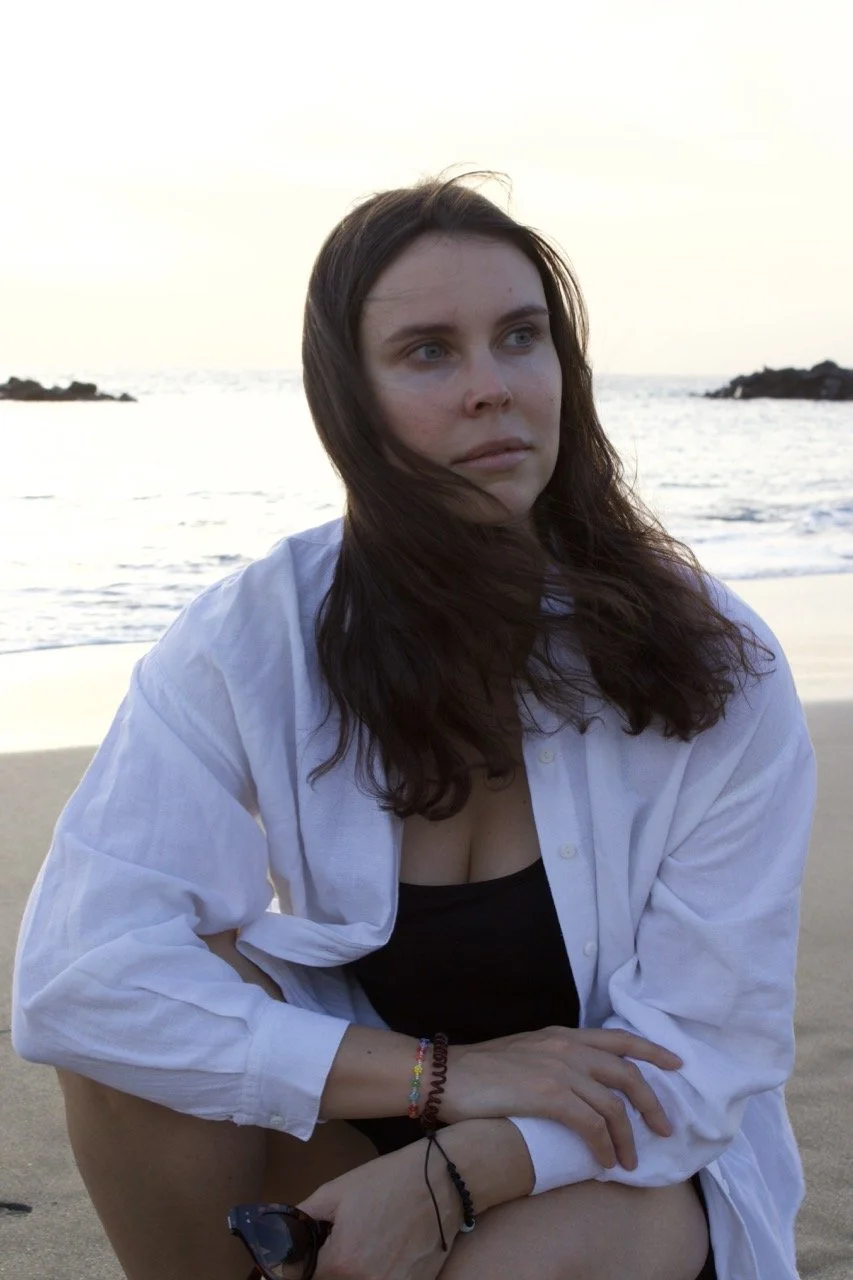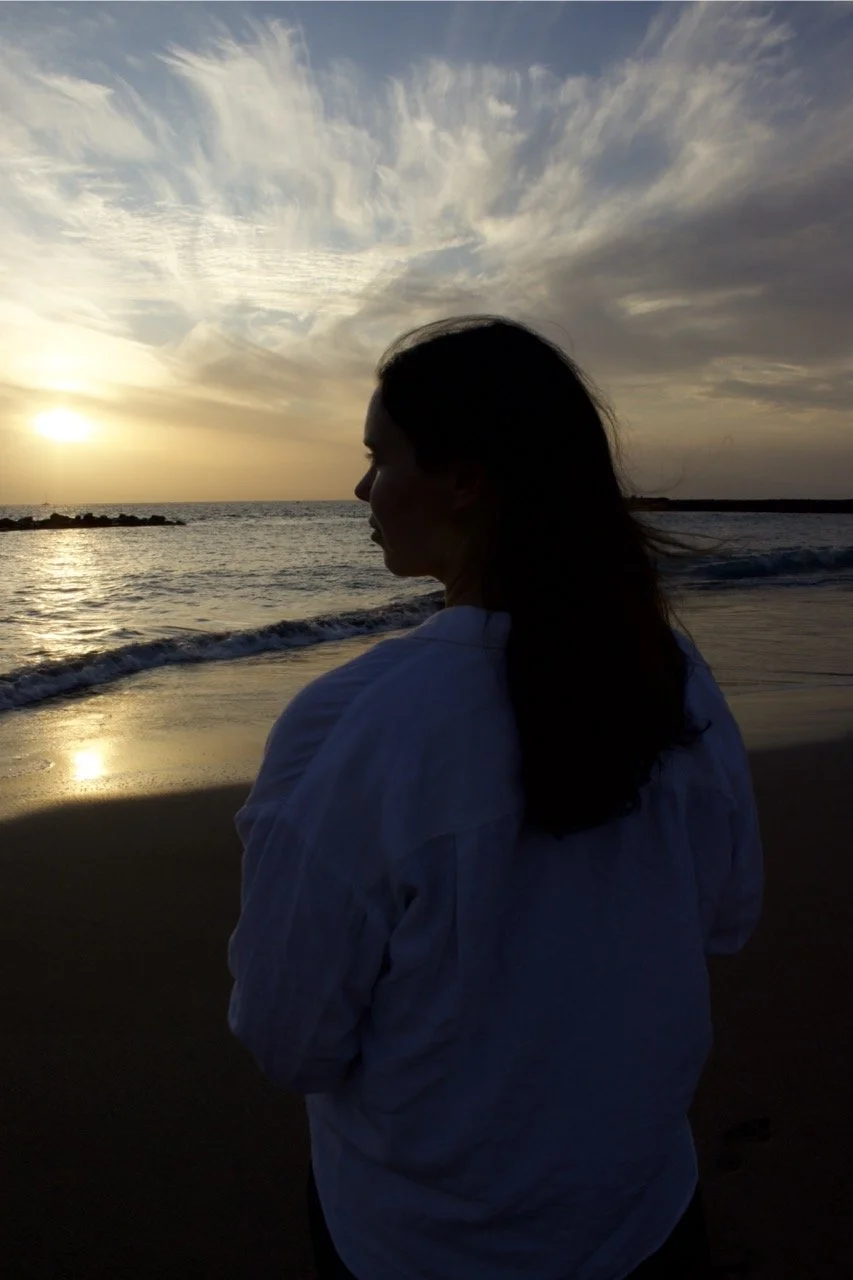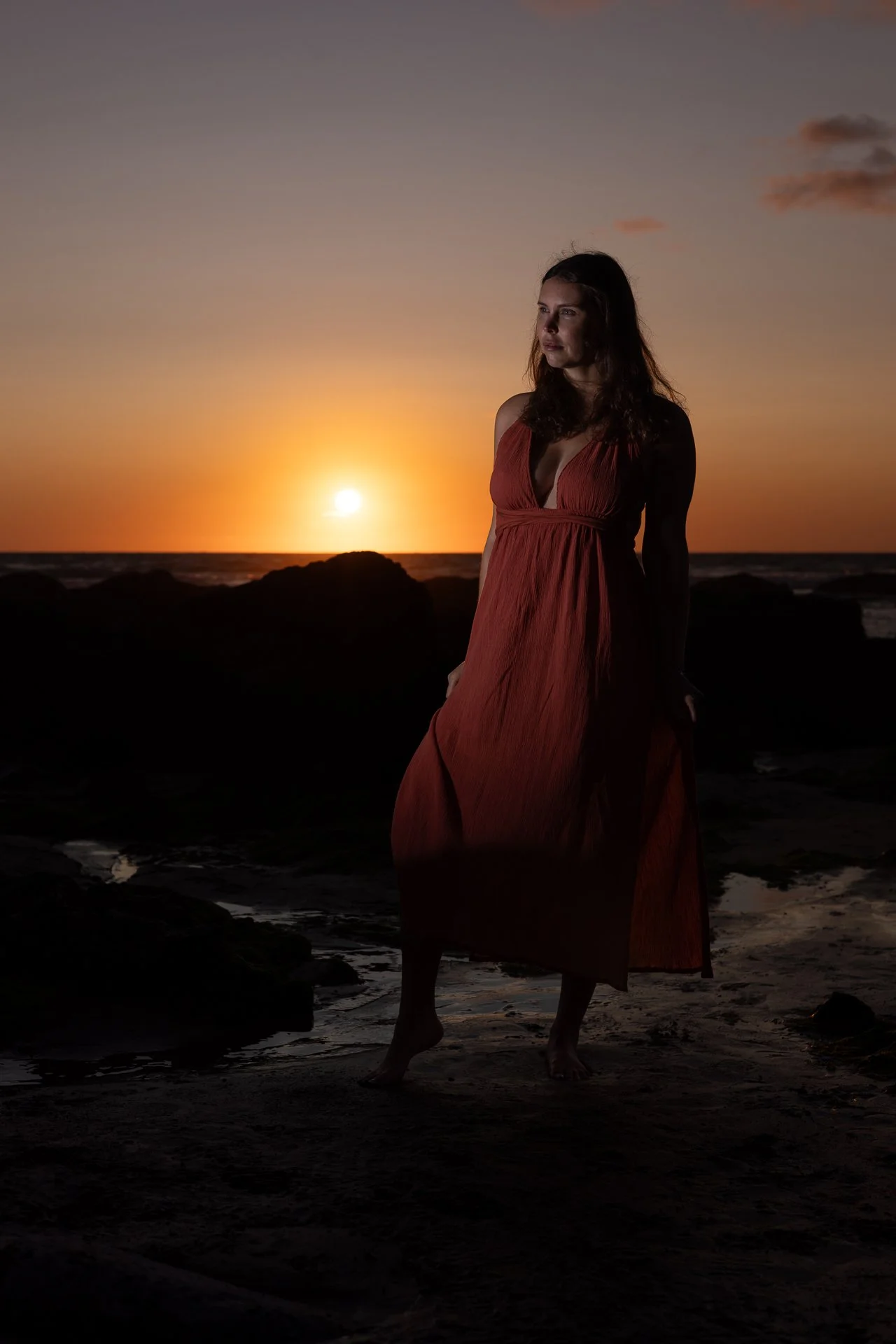Learning to Light: My First Sunset Model Shoot
The first time I tried a sunset model shoot, it nearly broke me. What followed was frustration, failure, and eventually… flash. 🔦
The Sunset That Broke Me 🌅
Last year we went away to Tenerife. The sunsets were unreal — streaks of gold and orange melting into volcanic rock, every evening begging to be photographed. I already had a growing portfolio of landscape work, and I was confident in those skills. But this trip was about pushing myself further — not just capturing the scene, but creating something from it.
I wanted to shoot sunset portraits. And there was only one person I wanted in front of the camera — Sabrina. She’s my partner, my constant, and the person who’s stood beside me (or in this case, in front of the lens) through every step of this chaotic photography journey. She’s also absurdly patient. Like, angel-level patient 😇.
And within 20 minutes, I’d completely blown it.
The sky? Gone.
The subject? Lost in shadow.
Every frame was a compromise — either the background looked stunning and Sabrina disappeared, or she was lit and the sky vanished into white.
I tried every trick I could think of. Adjusted settings, moved positions, prayed to the photography gods… nothing worked. We stayed out there well into twilight (golden hour had long since gone), chasing the light, chasing a result — but I couldn’t make it happen.
By the time we left the beach, I was exhausted. I’d felt confident going in, but walking back to the hotel, I felt like an imposter.
One More Try (and a Rooftop Bar) 🍻
That night, while Sabrina got ready for dinner, I sat on the bed with my camera beside me and a pint-sized identity crisis. I knew I needed help, so I started researching. Sunset portraits. Dynamic range. Balancing ambient light and subject exposure. I found tutorials, breakdowns, diagrams — and for the first time, some of it started to click ✅.
So the next evening, our final night, I decided to try again.
We headed up to the rooftop of the Hard Rock Hotel — a sunset bar perched above the town, with supposedly the best sunset views on the island. Incredible music, stunning views, and of course… a couple of well-earned Spanish cervezas 🍺. The perfect place to redeem myself.
I brought my old Canon 77D and started to apply what I’d learned. This time, I found a better balance. Sabrina didn’t disappear into shadow. The sky didn’t explode into pure white. Things were starting to line up.
And for the first time, I caught myself wondering:
Was I finally getting it? Was I starting to understand how to put the subject and the background in the same story — without sacrificing one for the other?
The results were better. Not amazing, but progress.
And honestly, progress felt like a win 💪.
As we packed up, an American guy struck up a conversation. Turns out he was a photographer too. We got talking about lighting, challenges, and the moments we all pretend we’re not panicking behind the camera. That chat calmed me down more than I expected. It reminded me I wasn’t alone.
We sat and chilled in the ambience of the rooftop bar, soaking up the atmosphere on our last night. The pressure had eased. The city lights from further around the coast flickered on ✨. And for the first time that week, I actually let go of the result.
Had I finally turned a corner?
Back home, I loaded up Lightroom with cautious optimism.
Could I rescue any of the shots?
Cue the classic dance of shadow lifting, highlight recovery, and “just a little more Dehaze…”
And while I did manage to bring a few images back to life, most of them weren’t what I’d hoped for.
I rescued a few. The rest looked like AI had a go and got confused by the concept of sunlight 🤖☀️.
I couldn’t keep winging it. Not if I wanted to improve.
I needed to learn how to do this properly.
The Flash That Sat in a Box 📦
A month or two later, Sabrina surprised me with the ultimate diploma support gift — a full flash photography kit.
We’re talking the full works: softbox, brackets, wireless trigger, flash, diffusers… the kind of stuff that turns your spare room into a studio.
And also, it turns your confidence into a puddle 😅.
The array of boxes sat unopened for months. Each one might as well have said: “Hope you know what you’re doing!”
I didn’t. Not yet.
But I’d recently seen a beach shoot on Instagram — a photographer using flash at sunset to create these dramatic, editorial-style portraits. It stopped me in my tracks. It was exactly the look I’d wanted but hadn’t known how to create.
So I did what I always do when I’m stuck: I researched 🎥.
I found two game-changing YouTube videos — one breaking down off-camera flash work in a way that finally made sense, and another focused entirely on sunset coastal portraits.
Suddenly, everything felt more possible.
I was confident.Too confident, maybe?
Packing, Pressure, and a 4:30am Start 🕓☕️
So we packed the car — flash gear and all — and hit the road.
Yet another early start. 4:30am this time.
No coffee, either — because every single chain coffee shop within a 10-mile radius refuses to open until 6am, which feels like a personal attack when you’re already arguing with a tripod in the dark. Starting a road trip without caffeine? Bold move.
This was Sabrina’s first time in Cornwall, and I’d been hyping it up for weeks.
Better beaches than anywhere else in the UK. Warmer weather (allegedly). Pasties. Cream teas.
I might’ve oversold it slightly, but I was desperate for her to love the place as much as I had as a kid.
The pressure was on… but the excitement was real, too.
We had two nights, three days, and the hope for a beautiful sunset at the beach our hotel overlooked 🌅.
No Camera (and No Sunsets… Yet) 🌥️
We arrived in Cornwall mid-morning — well before check-in — and left our bags in the hotel’s locked luggage room before heading out to explore Newquay.
I left the camera behind on purpose.
It’s important to step away from it sometimes — to actually be in the moment, without seeing everything through a viewfinder 📷.
It was warm. Too warm. Naturally, I got sunburnt.
Always wear lotion, kids 🧴.
Later that afternoon, I checked the weather. Completely overcast skies all evening.
That meant no golden hour, no cinematic light, and definitely no sunset shoot.
Honestly? I wasn’t even that mad.
We found a great place for food and drinks, enjoyed the evening, and got an early night.
Shooting could wait.
Scouting, Steak, and Sunset Pressure 🥩
The next morning, the blue skies returned ☀️.
We spent the day doing everything I’d hoped we would: shopping, beach time, grabbing food, and soaking up everything I loved about this part of the world.
It was Sabrina’s first time in Cornwall, and to my relief — she loved it.
The vibe, the views, the salty breeze coming off the coast… even the questionable seagulls with attitude (we named them Steven, obviously) 🐦.
She said it felt like a proper escape. Which, honestly, was all I’d wanted.
That afternoon, we scouted locations and found the perfect one: a rocky patch on Fistral Beach with small pools, green moss, and an open view west toward the sunset 🌊.
We even used Location Scout, a brilliant app that showed us exactly where the sun would hit the horizon. It felt like the final piece was in place.
That evening we grabbed a steak, watched the sky shift into gold, and started getting ready.
Then came the wind 💨.
Walking back along the beach, I started second-guessing everything. The breeze had picked up hard, and the idea of trying to balance a softbox and light stand in a coastal gust was… not appealing.
Would it hold? Would the softbox act like a sail and launch itself across the rocks? Would I end up in the sea trying to rescue a wireless trigger?
Maybe I was just scared. Maybe I was looking for an excuse not to try.
Sunset was around 21:30 — a late one — so we had time to relax.
But as golden hour crept in and the light turned perfect, I felt that familiar fire again.
“F*ck it — let’s go.”
The beach was almost empty, aside from a few dogs living their best life in the surf 🐕 — and their owners, of course, dutifully launching tennis balls like it was the final at Wimbledon 🎾.
Honestly, it was hard to tell who was walking who.
We made our way down the steps from the hotel, gear in hand, and returned to the spot we’d scouted earlier.
Sand, Softboxes, and Finally… A Shot That Worked 🎯
As I anchored the lightstand with my camera bag in the sand and attached the flash, I had a horrible sinking feeling.
(No, not quicksand — although my trainers did sink under the sand later in the shoot.
Had I forgotten something?
YES!
The diffuser panels for the softbox.
I could even picture them back on the hotel bed, flung out of the way to grab the camera batteries. Genius.
Swearing happened.
There was no way I was leaving Sabrina alone with all the gear to go back and get them — it was already getting chilly.
So we pushed on.
To be fair, the harsh flash gave the whole thing a dramatic, cinematic look — and once I leaned into that, it kind of worked.
In my head, it felt like we were halfway between a moody fashion shoot and a Marvel movie poster.
We fired a few test shots — first exposing for the sky to test the theory. It worked.
Then I took a few of Sabrina.
They were… good.
Like, actually good 👀.
Now we were back in that familiar tension — light vs dark, sunset vs subject. I re-exposed for the sky, repositioned the lightstand, and fired off another shot.
It was close… but not quite.
That’s when I realised I’d forgotten to turn on High-Speed Sync. And the flash power was still cranked too high.
I dialled it back to 1/2, flicked the HSS switch, and tried again.
Boom.
It worked.
Sabrina helped with posing — I’m not exactly a natural director, so we went with relaxed, natural movement and it paid off.
We kept shooting, tweaking, adjusting, until the sun hit the water.
And finally… we had something. Not just something. We had photos I was proud of 🧡.
We packed up, brushed sand off the gear, and walked back to the hotel.
Feet tired. Clothes salty. Camera memory card buzzing.
Cider and Confidence 🍏
Back at the hotel, we headed straight to the bar — ordered a cold Cornish cider each and loaded the memory card into my phone.
Even Sabrina, who is usually her own harshest critic, said:
“I actually love ten of these.”
That’s how I knew we’d done it.
I’ll always be a perfectionist — I can already list the things I’d do better next time.
(Like not forgetting the diffuser. Absolute rookie move.)
But the point is… I did it.
And I want to keep doing it — better, smarter, and with a bit more sunscreen.
How to Practice Sunset Flash Photography 🌇
💡 1. Start with ambient exposure
Dial in the settings you want for the background — aperture, shutter speed, and ISO — before turning on your flash.
💡 2. Use flash to light your subject (not the other way round)
You’re not using flash to blast light all over the scene. You’re using it to bring your subject up to match your background. That mindset shift helped me a lot.
💡 3. High-Speed Sync (HSS) is your best friend
If you’re trying to shoot wide open (like f/2.8) at sunset, your shutter speed will likely need to go above 1/200. HSS lets your flash keep up.
💡 4. Start around 1/4 to 1/2 flash power
From there, go up or down based on your histogram and test shots. Avoid full power unless absolutely necessary — recycle times will slow you down.
💡 5. Work fast — light changes quickly
Sunset waits for no one. Have your gear ready, know your plan, and test your setup early if you can.
💡 6. Get a sandbag or use your camera bag as an anchor
Trust me, one gust of wind and your lightstand is off to sea. Ask me how I know 🏄♂️.
Final Thought 💭
This shoot wasn’t perfect. It didn’t need to be.
But it was the first time I walked away from a sunset portrait shoot feeling like I understood what I was doing — not just why things weren’t working, but how to make them work.
That’s the win.
Here’s to more light, more learning… and more shots that don’t require me to rescue equipment from the ocean.






